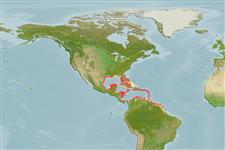>
Clupeiformes (Herrings) >
Dorosomatidae (Gizzard shads and sardinellas)
Etymology: Harengula: Old English haring, hering = mackerel, the fish Clupea harengus (Ref. 45335).
More on author: Cuvier.
Environment: milieu / climate zone / depth range / distribution range
Écologie
marin; saumâtre récifal; profondeur 0 - 50 m (Ref. 188). Subtropical; 31°N - 7°S, 99°W - 47°W (Ref. 188)
Western Atlantic: Gulf of Mexico and southeastern Florida to northern Brazil, including the Bahamas, the entire Caribbean and the West Indies.
Length at first maturity / Taille / Poids / Âge
Maturity: Lm ?, range 7 - ? cm
Max length : 22.5 cm TL mâle / non sexé; (Ref. 126891); common length : 10.0 cm SL mâle / non sexé; (Ref. 188); poids max. publié: 109.00 g (Ref. 126891)
Épines dorsales (Total): 0; Rayons mous dorsaux (Total): 15-21; Épines anales 0; Rayons mous anaux: 12 - 23. Tooth-plate on tongue and tooth plate behind it (basihyal and basibranchials tooth plates) broad, their width about 3 to 5 times in their combined length, the basibranchial tooth plate with a distinct bulge in front. Scales fairly strongly attached, not easily lost. No dark pigment on dorsal fin tip (Ref. 188). Silvery, with a dark greenish back. Diffuse yellow or pale orange spot at edge of opercle. Body slender, lower profile not strongly curved (Ref. 7251).
Occurs in coastal waters, estuaries and lagoons, tolerating low salinities. Can tolerate a broad range of salinity levels (Ref. 26938). Forms schools, small individuals often along sandy beaches. Its flesh has an unpleasant odor. Utilized as fishmeal (Ref. 5217).
Life cycle and mating behavior
Maturité | Reproduction | Frai | Œufs | Fécondité | Larves
Whitehead, P.J.P., 1985. FAO Species Catalogue. Vol. 7. Clupeoid fishes of the world (suborder Clupeoidei). An annotated and illustrated catalogue of the herrings, sardines, pilchards, sprats, shads, anchovies and wolf-herrings. FAO Fish. Synop. 125(7/1):1-303. Rome: FAO. (Ref. 188)
Statut dans la liste rouge de l'IUCN (Ref. 130435)
Menace pour l'homme
Harmless
Utilisations par l'homme
Pêcheries: intérêt commercial mineur; appât: usually
Plus d'informations
CollaborateursImagesStamps, Coins Misc.SonsCiguateraVitesseType de nageSurface branchialeOtolithesCerveauxVision
Outils
Articles particuliers
Télécharger en XML
Sources Internet
Estimates based on models
Preferred temperature (Ref.
123201): 24.3 - 28, mean 26.8 °C (based on 230 cells).
Phylogenetic diversity index (Ref.
82804): PD
50 = 0.5625 [Uniqueness, from 0.5 = low to 2.0 = high].
Bayesian length-weight: a=0.00891 (0.00791 - 0.01004), b=3.05 (3.02 - 3.08), in cm total length, based on LWR estimates for this species (Ref.
93245).
Niveau trophique (Ref.
69278): 3.3 ±0.3 se; based on diet studies.
Generation time: 2.6 ( na - na) years. Estimated as median ln(3)/K based on 1
growth studies.
Résilience (Ref.
120179): Haut, temps minimum de doublement de population inférieur à 15 mois (Preliminary K or Fecundity.).
Fishing Vulnerability (Ref.
59153): Low to moderate vulnerability (28 of 100).
Nutrients (Ref.
124155): Calcium = 64.6 [30.1, 127.7] mg/100g; Iron = 1.01 [0.50, 1.87] mg/100g; Protein = 20.1 [18.8, 21.4] %; Omega3 = 0.39 [0.21, 0.71] g/100g; Selenium = 14.5 [6.7, 31.4] μg/100g; VitaminA = 65.7 [20.2, 208.6] μg/100g; Zinc = 1.1 [0.7, 1.8] mg/100g (wet weight);
